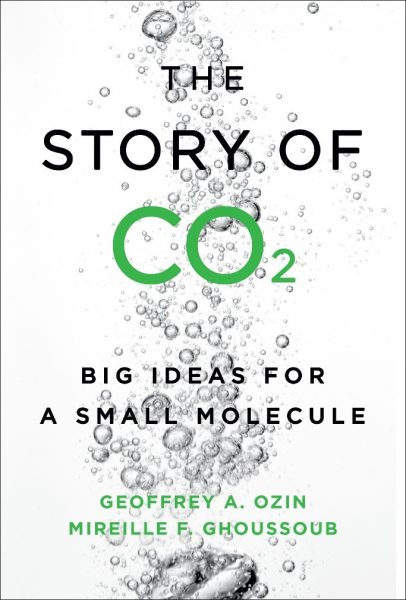The inspiration to write The Story of CO2: Big Ideas for a Small Molecule emerged from the question of how to connect our research in materials chemistry to the greater challenge of tackling the climate crisis. In our lab, we strive to develop nanoscale materials capable of transforming carbon dioxide into alternative products. As such, our work is inherently focused on events that occur at the atomic scale. Attempting to extrapolate the potential impact and relevance of our research to the complex, global scale crisis is, at best, non-trivial. However, the chemical properties of materials are fundamental to many of the low-carbon innovations that can help us get a handle on our emissions.
Like many researchers around the world whose work is not COVID-19-related, physical distancing measures have brought our laboratory activities to a complete halt. After mourning the loss of long-anticipated experiments, graduation defenses, and newfound career uncertainties, most of us have come to understand that working from home with pay during this time is nothing short of a privilege. And yet, I imagine that many in academia, like myself, in moments of self-importance, have felt a tinge of defensiveness in response to being deemed non-essential out of fear of not mattering. But personal insecurities aside, it is a healthy exercise to confront the truth about the relevance of our work, whether or not we had thought of it before. What role can we play, as researchers and more importantly as community members, both during and after this crisis? What does research on CO2, let alone a book on CO2, matter in the midst of a pandemic?
As we find ourselves trying to “flatten the curve” through global paralysis, atmospheric CO2 concentrations continue to rise, with meteorologists predicting 2020 to be the hottest year on record. The climate crisis and the COVID-19 pandemic might appear to be two separate, compounded crises; however, they are more connected than meets the eye. Rather than putting climate action on the back burner, the current global health crisis has made action more relevant than ever before.
For one, the pandemic has laid bare the most glaring rifts in our social fabrics. Far from being the “great equalizer”, COVID-19 has only exacerbated the social and economic inequities that already plagued our communities. Similarly, the extreme weather events and environmental changes caused by global temperature rise will continue to pose the greatest risk to the most vulnerable among us. In the event of a heat wave, drought, or wildfire, robust public healthcare infrastructure and rapid government response will likely to be bigger determinants of community health outcomes than the severity of the event itself.
Although often presented as a strictly environmental and economic issues, climate change is itself a public health crisis. Ignoring calls to action on the environment will only increase the likelihood of future outbreaks, in addition to making us more vulnerable to infection. As M.D. Antonia Sappong put it during a live webcast in honour of the 50th Anniversary of Earth Day, “Human health is founded on the health of our natural systems. […] Any vulnerabilities someone has are shared vulnerabilities.”
If there is one thing to be learned from the current pandemic, it is that swift action is possible. Within a matter of weeks, governments of many countries mobilized — albeit some questionably slower than others — and coordinated in an international effort to isolate epidemics and prevent further spread of the virus. States of emergencies were declared, new programs to address unemployment were created, and industries re-adapted to meet the demand for medical equipment and supplies. The actions taken over the past several weeks have demonstrated the feasibility of a green economic stimulus or Green New Deal to rapidly transition to a sustainable circular economy that will guarantee net zero emissions by 2050. Investing in renewable energy infrastructure, scaling up low-carbon industrial processes, creating high-quality jobs, and introducing strong climate and environmental policy will go a long way towards improving public health and getting global carbon emissions under control. As a recent study published in Nature put it, “countries could benefit from avoiding potential climate impacts through more stringent mitigation efforts”.
The on-going public health crisis has also highlighted the role of science in protecting human health and the environment. The collective response to calls for physical distancing has largely been the consequence of effective science communication, and leaders who have engaged in evidence-based decision-making and laid out clear public health policy have earned public trust and respect. Similarly, science-informed policy must lie at the health of a green stimulus plan, with science communicators taking on public roles to help guide communities through the transition.
Admittedly, we do not offer a complete solution to the climate crisis in our book. Climate change is an inherently complex social, economic, and environmental problem and therefore no single technology will ever serve as its silver bullet. Yet, The Story of CO2 may have newfound relevance in light of the fact that, despite global lock downs, carbon emissions are predicted to fall by a mere 5% this year — over 2% short of the annual target needed to limit temperature rise to 1.5 °C. Should we not have observed a more profound and immediate impact on our carbon footprint after abandoning international air travel and staying in our homes? While a halt in transportation is the primary reason for the 5% drop in emissions, the limited impact of our behavioral changes reveals the enormous contributions of less visible economic sectors — fossil-based energy generation, steelmaking, chemical manufacturing, and cement production have all continued amidst the global pandemic.

Hopefully the current situation demonstrates why a coordinated systems-level approach is needed to achieve meaningful emission reductions. At the heart of the transition lies the need to develop and expand our renewable energy. In addition to decarbonizing our energy sector, many industries that rely on fossil resources for chemical feedstock will need to take serious steps towards reducing their emissions.
This is where The Story of CO2 comes in: the book explores the many ways in which waste CO2 can replace petroleum-derived products to assist industries in the transition to a fossil-free circular economy. The story offers a glimpse into the cutting-edge science and emerging technologies that can transform CO2 into essential products, such as chemicals, polymers, pharmaceuticals, and fuels. We sincerely hope that The Story of CO2 inspires readers with the hope and knowledge that alternative solutions do exist, even for industries that have been proclaimed as especially hard to decarbonize.
And so, despite the current hardships we face, both personal and collective, let this moment serve an as opportunity to re-imagine a better future that centers the well-being of both people and the planet.
The Story of CO2: Big Ideas for a Small Molecule, by Geoffrey Ozin and Mireille Ghoussoub, is anticipated for release in October 2020 by University of Toronto Press. Pre-orders now available.

















